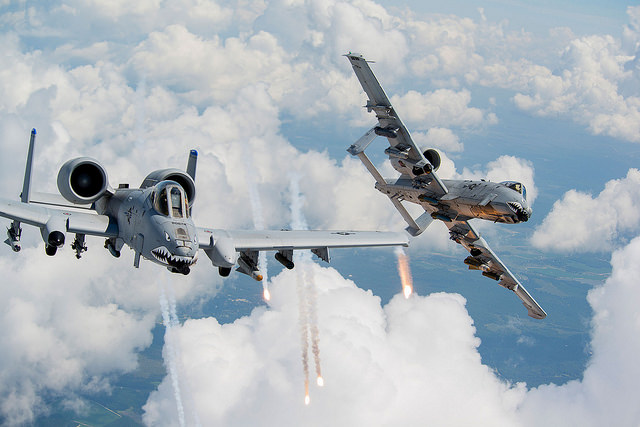The US Government Accountability Office (GAO) has raised doubts about a US Air Force claim that retiring the Fairchild Republic A-10C Thunderbolt II would save the government $4.2 billion over five years, and says capability gaps will emerge without the close-in attack aircraft.
In a new report sent to Congress, the GAO says that the savings estimate is “incomplete and may overstate or understate” the actual amount. The document also claims that alternative cost-saving measures raised by the air force “were rough estimates that were illustrative only and not fully considered as alternatives to A-10 divestment”.
The report comes amid a heated debate between US lawmakers and the military about the wisdom of retiring the old but effective close-air-support aircraft. USAF sought to cut the aircraft in its fiscal year 2015 and 2016 budget requests, but so far lawmakers have blocked the move at every turn.

US Air Force
The report, published 25 June, says the air force will not be able to fully support the close air support (CAS) mission without the A-10 Thunderbolt II, more commonly called the “Warthog”.
“We found that air force divestment of the A-10 will create potential gaps in CAS and other missions,” wrote the report’s author, John Pendleton.
The air force says the A-10 would be phased out over several years as the mission transfers to multirole fighter jets like the Lockheed Martin F-16 Falcon and Boeing F-15 Eagle, and to the newer Lockheed Martin F-35 Joint Strike Fighter as it comes online. But a Department of Defense planning scenario set in 2020 concluded that divesting the A-10 increases operational risk, the report says. Details about these potential capability gaps are classified, it adds.
The A-10 is considered to be among the best CAS platforms ever produced, and it also provides air cover to helicopters conducting combat search and rescue operations. The air force also needs them to train and qualify its joint terminal attack controller (JTAC).
The air force has plans to transfer some of its more experienced CAS operators to F-16 and F-15 squadrons, and says more JTAC training can be done with simulators.
In response to the GAO report, service secretary Deborah Lee James said the cost of keeping the A-10 would be to the detriment of the air superiority and global strike missions. She says keeping the A-10 would also mean fewer aircraft maintainers will be available to support new F-35 squadrons.
“Each of the combatant commanders support fielding advanced warfighting capabilities and would rather cut the A-10 when compared to cuts to higher priority mission areas,” she said in a 3 June letter to the GAO.
The air force has considered purchasing a low-cost A-X jet, but can’t afford it. “We certainly would like to have something that operates more efficiently than other airplanes we have today, that brings more firepower [and] that we can use in a low-threat environment,” USAF chief of staff, Gen Mark Welsh, said in April.

US Air Force
Source: FlightGlobal.com
















